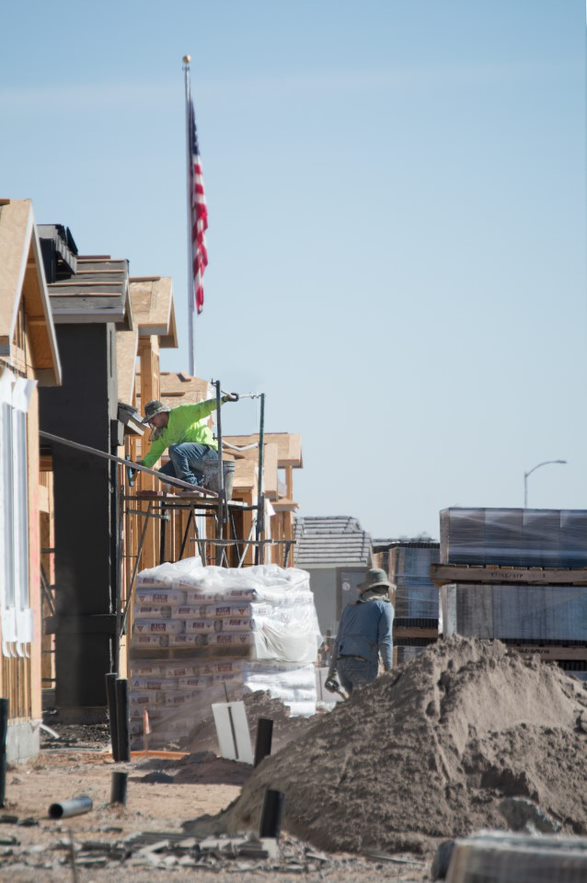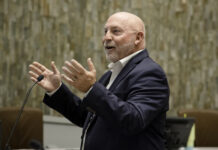![Constuction on Palo Brea homes. [file]](https://www.inmaricopa.com/wp-content/uploads/2021/11/thumbnail-9-696x463.jpg)
News flash — Maricopa is growing. Fast.
But if you think you have a grasp of how big Maricopa might be down the road, you’d better think again, because City Manager Rick Horst has some numbers that will blow your mind.
“We envision our city alone — and people get nervous when I say this, because it will be decades from now — we’ll be a million people one day,” Horst said. “Just because of our growth and our size, the area we have. So, think of three Chandlers, and that’s going to be us someday.”
The city is off and running toward those numbers. Today, there currently are nearly 6,000 acres of land in one stage of development or another, from the pre-application process to finishing lots and preparing for construction. That amount of land will yield 20,618 combined dwelling units — both single-family homes and apartments, although the vast majority are single-family homes.
Given that number of units, the city is looking at adding another 54,000 people over the next decade or so, which would bring the city’s population to about 125,000. There are lots of reasons why.
According to Greg Davis, the president of Chandler-based Iplan Consulting, which is working on one of the larger developments, the 1,886-acre Santa Cruz Ranch at the southwest corner of Maricopa-Casa Grande Highway and Murphy Road, it’s all about available land.
“The sections of land that are available in the far east or west Valley are there, but they are farther away from central Phoenix than Maricopa is,” Davis said. “They’re also more expensive. That’s why we’re seeing Maricopa come to the top of the list of places to build. Geographically it’s actually closer than those other places. And Maricopa is especially attractive with all the new jobs coming into the southeast Valley and being so close.”
Mayor Christian Price was told the same thing in a recent meeting with Land Advisors Organization, a Scottsdale company that consults with land developers when they showed him a map of the entire metro Phoenix area, from Anthem to Casa Grande and Buckeye to Queen Creek.
Price said Land Advisors told him and Horst, “There is not a single spot of land anywhere in here that is not either in a holdout position, where a family owns it, and they don’t want to sell it; that has been purchased and is already slated for development; or is currently under development in some fashion. There is not a single plot of land that doesn’t fall into one of those categories. You guys — Maricopa — are all that’s left. You’re the last bastion.”
Price said that makes Maricopa ground zero for every site selector looking for land in and around the Valley.
“We’ve been working toward this for 10 years,” Price said. “We’ve been laying the foundation for years to take advantage of this situation…and now it’s about to happen.”
Davis said it’s just the way growth works. Like many who thought 10 or 20 years ago that land in San Tan Valley, Queen Creek, Goodyear or Buckeye might be so far out that it would never be developed, those are now some of the hottest growth areas in metro Phoenix. And he said Maricopa is next.
“It’s the next logical extension of growth for the Valley,” he said.
“All the infill spots are spoken for, or they are going to higher density projects like apartments. There are fewer and fewer opportunities to find the large tracts of land that are needed for single family home developments and Maricopa has them.”
For those who would rather see Maricopa maintain a more rural lifestyle and put off all the growth, both Horst and Seth Keeler, the project manager of the Santa Cruz Ranch project for master developer W Holdings, offer a note of encouragement.

“I think it’s important to note that a lot of people think, ‘Oh, that’s going to happen tomorrow,’” Horst said. “It’s not going to happen tomorrow. It’s going to take years if not decades for it all to be realized. And people say we’re not ready for it, and they are right, we’re not ready now. But we’ll get ready for it incrementally as the development occurs.”
Keeler said his project is well down the road from beginning construction.
“We haven’t even started those projections,” he said when asked about a construction timeline. “The project is zoned for a master planned community. It was zoned several years ago in the county.
We’ve had the land for a while, and it is currently still being farmed. There’s still a pretty good amount of time until we put shovels in the ground, maybe a couple of years. A lot of factors go into play. We haven’t even engaged any builders yet. When we do get to that point, that’s when we’ll get more of a firm timeline on when construction will start.”
Annexation on the way
One thing that will happen as part of the growth process is the annexation of a tremendous amount of land. Many of the projects in discussions lie south of Maricopa’s city limits, yet within the city’s immense planning area, which stretches from Interstate 10 to the border of Goodyear an area spanning 252 square miles. To provide the level of services the residents of those communities will require, they will need to be annexed into the city. Horst said any annexation will be voluntary, not forced. That will then provide those residents with an enhanced level of public services like police and fire services, as well as street maintenance and other necessities.
And it will all be ready when the time comes, Horst said.
“Remember, 18 years ago when the city was founded, we had 1,040 people,” he said. “Now we have 70,000, and we managed to grow and build roads and build fire and police forces and public works and libraries to support these first 70,000. It makes sense that we can do it for the next 70,000 too. But we didn’t snap our fingers, and all of this was here. It had to be planned for and had to be funded and had to be built one step at a time. And while we’re not perfect, I think if you look at it compared to some other cities, we’re doing pretty well for an 18-year-old city.”
He said the growth will all happen as it needs to. Where the city has four fire stations now, it will build number five, then number six. The same will happen with police, although Horst said the number of police officers in a city is not a product of population, but rather of need. So, a city with a low crime rate like Maricopa needs fewer officers per thousand population than a city with a lot of crime.
He added that is a primary reason the city puts a heavy emphasis on public safety in our town — and not just in a traditional sense.
“Public safety doesn’t just mean police and fire,” he said. “It means having things for children to do, it means quality of life, good parks, libraries, all the things that attract families to want to come and live here. So, when we talk about public safety it’s a whole lot more, than just police and fire.”
Horst said it is beneficial to both the city and the residents of these outlying areas to have them annexed into the city.
“If we don’t annex, those projects are still going to build, and you still have the impact from them on city services,” he said. “But now the city doesn’t control it and they don’t pay us the fees to fix the problems. You’ll have all the impacts without the fees to resolve or mitigate those impacts. They’ll use our parks, they’ll use our libraries, we’ll be the closest police and fire, but they won’t be paying taxes to the city, so the burden falls to the taxpayers within the city. So, you want to have a living, breathing, growing city, but you want to do it right.”
The developers of the new communities coming to town will pay for the expansion and enhancement of those services through the impact fees they pay the city.
The current impact fees for residential developments in south Maricopa are $6,243 per single-family home ($2,965 for streets, $1,207 for parks and recreation, $131 for libraries, $496 for police services, and $1,444 for fire services. Multi-family units pay a total of $4,508 per unit, with $814 going to parks and recreation, $88 for libraries, $334 for police and $973 for fire.
Fees are higher in the south part of the city as it is farther away from the existing facilities.
“It all depends on the impact, why it’s called an impact fee,” Horst said. “It’s based on units, based on traffic counts, it’s different if it’s a residential vs. commercial project. For instance, a Circle K has hundreds of cars a day in and out, whereas a home you come and go only so many times a day. Homes have the least amount of traffic impact vs. commercial. Most people don’t understand that; they see homes and think, oh no, we’re going to increase our traffic. And yes, we are going to increase our traffic, but we will manage that traffic, so it falls within our standards.”
Davis said his clients see the growth in Maricopa as a positive and think the city offers a terrific opportunity.
“My clients are high on Maricopa the city,” he said. “They are expanding the infrastructure in terms of roads and also things like restaurants and shopping, so people don’t have to leave town for those things any more like they used to.
And Horst said he sees both points of view when it comes to growth and development vs. those who want to live a more rural lifestyle.
“I’d probably take two tracks,” he said. “All those farmers and ranchers who lived in what is now the incorporated city of Maricopa years ago, they all elected to sell. They all took the money and put it in the bank and they probably retired. Number two, those who elected to stay, no one’s ever going to encroach on their two- or three-acre lot if they don’t want to sell. No one is going to change their lifestyle – what they do, what they eat, what to enjoy — not at this level of government. But at the same time, he doesn’t have the right to tell his neighbor how to enjoy his land either, or whether or not to sell it. So, it’s a balance.
“That’s ultimately what community is. Community is a balance.”
This story was first published in the December edition of InMaricopa magazine.

![3 things to know about the new city budget Vice Mayor Amber Liermann and Councilmember Eric Goettl review parts of the city's 2024 operational budget with Mayor Nancy Smith on April 24, 2024. [Monica D. Spencer]](https://www.inmaricopa.com/wp-content/uploads/2024/04/spencer-042424-preliminary-budget-meeting-web-218x150.jpg)






![MHS G.O.A.T. a ‘rookie sleeper’ in NFL draft Arizona Wildcats wide receiver Jacob Cowing speaks to the press after a practice Aug. 11, 2023. [Bryan Mordt]](https://www.inmaricopa.com/wp-content/uploads/2024/04/cowing-overlay-3-218x150.png)



![Alleged car thief released without charges Phoenix police stop a stolen vehicle on April 20, 2024. [Facebook]](https://www.inmaricopa.com/wp-content/uploads/2024/04/IMG_5040-218x150.jpg)

![3 things to know about the new city budget Vice Mayor Amber Liermann and Councilmember Eric Goettl review parts of the city's 2024 operational budget with Mayor Nancy Smith on April 24, 2024. [Monica D. Spencer]](https://www.inmaricopa.com/wp-content/uploads/2024/04/spencer-042424-preliminary-budget-meeting-web-100x70.jpg)



But yet we can’t seem to fix Rt. 347……bwhahahahahaaa. They are amateurs from the mayor, the city manager, and the useless volunteer P & Z committee.
This entire article is supposed to be how great Maricopa can be and how we can grow 50k+ people. Yet they leave out the blaring problem here, the traffic is already a huge problem and you think adding more people is supposed to make the current citizens excited?? How can a group of people who are supposed to care about it’s citizens actually this deaf and blind?! Come up with a solution to fix the traffic, fix the 347, and or come up with a solution on a different way to the 10. Take care of us and we too can get excited about growth.